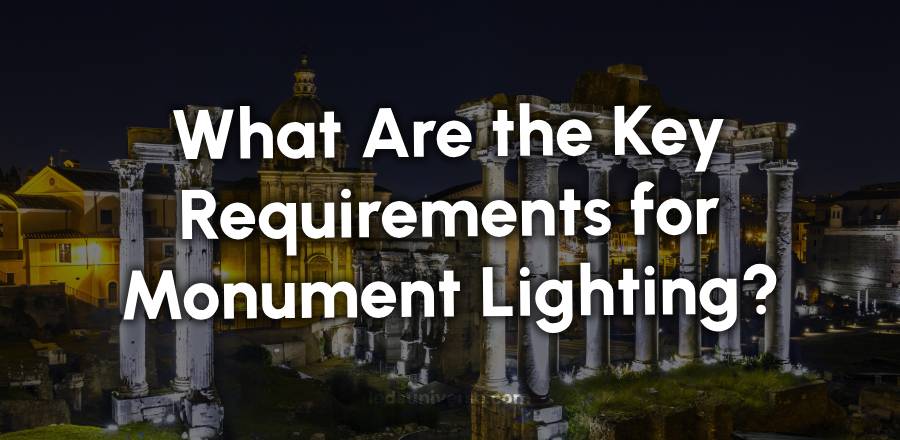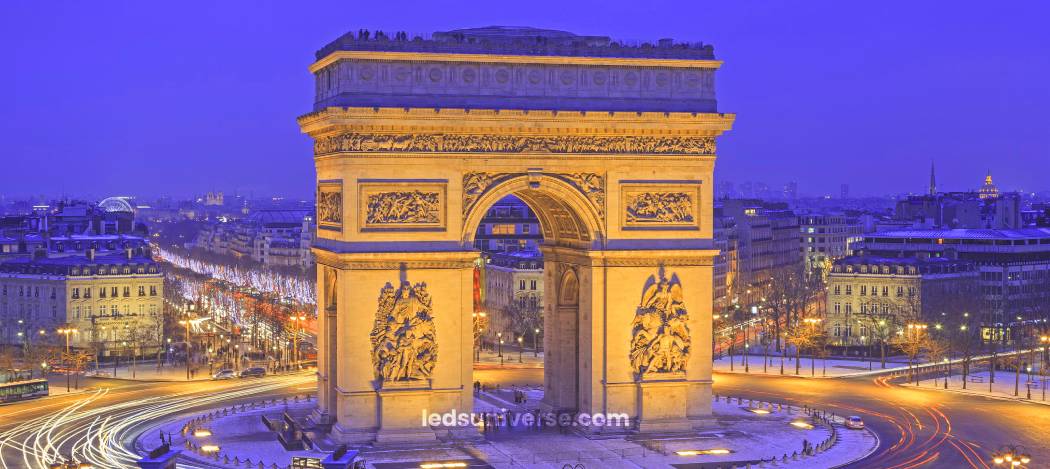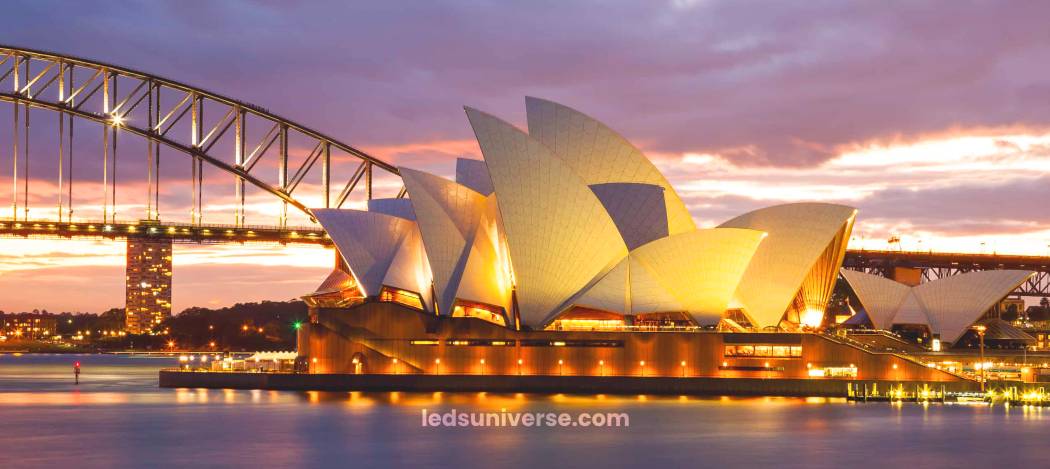
Thoughtfully designed illumination enhances their visual impact, ensuring they remain inviting and visible to visitors while adding a layer of safety. Various factors influence the choice of lighting, including design aesthetics and technical specifications, all of which contribute to a monument’s ability to tell its story and engage the public.
A variety of factors influence the selection of lighting solutions, ranging from aesthetic considerations to technical specifications. By understanding the principles of effective monument lighting, one can appreciate how thoughtful design enhances the monument’s features, context, and overall experience for those who encounter these significant landmarks.
Reach out for free lighting consultation
Table of Contents
ToggleMonument lighting encompasses a variety of techniques and technologies designed to illuminate monuments effectively. The primary goal is to create an appealing visual impact while also ensuring that the monument can be appreciated after dark. This involves selecting appropriate lighting fixtures, placement, intensity, and color temperature, among other factors.

Lighting design is an art that blends creativity and technical skills. It requires an understanding of both the architectural and historical significance of the monument, as well as the surrounding environment. Effective lighting design can transform a monument into a striking visual focal point at night, drawing attention and creating an inviting atmosphere for visitors.
The lighting design process begins with a thorough assessment of the monument’s characteristics, including its size, material, and any intricate details that may be highlighted through strategic lighting. Moreover, the lighting design should complement the surrounding landscape and architecture, ensuring harmony in the overall visual composition.
Monuments often hold historical and cultural significance, representing important events, figures, or ideologies. Therefore, the lighting should respect the monument’s heritage and convey its story effectively. In many cases, local customs and community values should influence the lighting choices, including the intensity, color, and type of lighting used.
Selecting the appropriate type of lighting is essential for achieving the desired effect. Various lighting techniques can be applied depending on the monument’s design and the surrounding environment.
Uplighting involves positioning fixtures on the ground and directing the light upward towards the monument. This method can create a dramatic effect, emphasizing the height and grandeur of the structure. Uplighting is often used to highlight architectural features, textures, and materials, adding depth and dimension to the monument.
However, care should be taken to avoid overexposure, which may lead to glare or wash out intricate details. Choosing fixtures with adjustable beams and intensity settings can provide greater control over the lighting effect.

Downlighting, on the other hand, involves placing fixtures above the monument and directing light downwards. This technique can create a soft and inviting ambiance, mimicking natural light conditions. Downlighting can illuminate pathways and surrounding areas, enhancing safety while complementing the monument’s features.
This method is particularly useful for monuments located in parks or public spaces where surrounding flora can be highlighted, creating a beautiful interplay of light and shadow.
Accent lighting serves to draw attention to specific features of a monument. This can include intricate carvings, inscriptions, or unique architectural elements. By using focused beams, accent lighting can create a stunning visual impact that encourages visitors to appreciate the finer details.
Accent lighting can be achieved through spotlights or adjustable fixtures that allow for precise placement. Care should be taken to balance accent lighting with other techniques to maintain a cohesive visual experience.
Flood lighting provides broad illumination, making it suitable for larger monuments or those situated in expansive areas. Floodlights can cast a wide beam of light, ensuring the entire monument is visible from various angles. This method is often employed for monuments located in busy public spaces where visibility is paramount.
However, flood lighting may also introduce challenges, such as light pollution or oversaturation. Careful planning and fixture selection can mitigate these issues and ensure a balanced approach to illumination.
Beyond the artistic and design elements, technical specifications play a vital role in the successful implementation of monument lighting. Understanding these factors can ensure that the chosen lighting solutions are not only visually appealing but also functional and sustainable.
Selecting the right light source is fundamental to achieving the desired lighting effect. Various options are available, including incandescent, LED, and halogen lighting.
LED lighting has gained popularity due to its energy efficiency, longevity, and versatility. LEDs produce less heat than traditional incandescent bulbs, reducing the risk of damage to sensitive materials. Additionally, LEDs can offer a range of color temperatures, allowing for tailored lighting solutions that align with the monument’s aesthetics.
Halogen lighting, while offering excellent color rendering, may generate more heat and require more frequent replacements. In contrast, incandescent lighting, though warm in tone, is less energy-efficient and may not be suitable for prolonged use.
The color temperature of the light source can dramatically influence the visual impact of a monument. Warmer color temperatures (around 2700K to 3000K) tend to create a cozy and inviting atmosphere, while cooler temperatures (above 4000K) can produce a more stark and modern effect.
Choosing the right color temperature is essential for maintaining the monument’s character and ensuring that materials appear true to their natural hues. High-quality light sources with good color rendering capabilities (CRI of 90 or above) can enhance the visual experience and allow visitors to appreciate the monument’s details as intended.
Incorporating lighting control systems can enhance the functionality and versatility of monument lighting. These systems can allow for adjustments in intensity, color, and timing, enabling different effects to be achieved for various occasions or seasons.
For instance, certain monuments may benefit from seasonal lighting schemes, such as softer lighting during holidays or special events. A well-designed control system can ensure that the monument remains visually appealing year-round while offering flexibility in its presentation.
Considering the environmental impact of monument lighting is increasingly relevant in today’s society. Energy-efficient lighting solutions not only reduce operational costs but also minimize the carbon footprint associated with monument illumination.
Utilizing renewable energy sources, such as solar-powered lighting, can further enhance sustainability efforts. Solar lights can be installed in areas with ample sunlight, offering a viable solution that aligns with environmental goals.
Additionally, minimizing light pollution is vital for preserving the night sky and protecting local ecosystems. Using appropriate shielding and directing light where needed can help reduce stray light while maintaining the monument’s visibility.
Beyond aesthetic and technical considerations, safety and security are paramount when designing monument lighting. Ensuring that pathways and surrounding areas are adequately illuminated enhances visitor safety and deters potential vandalism or criminal activity.

Strategic lighting of pathways and open spaces surrounding the monument can create a safe environment for visitors. Well-lit pathways reduce the risk of accidents and provide a welcoming atmosphere for those exploring the site.
Additionally, incorporating motion sensor lighting can enhance security by illuminating areas only when needed, further deterring unwanted activity.
Incorporating emergency lighting solutions can provide added safety for visitors in case of power outages or emergencies. These systems can ensure that key areas remain illuminated, guiding visitors safely away from the monument.
Considering emergency lighting in the design phase can help create a comprehensive safety plan that addresses potential risks associated with nighttime visits.
Effective maintenance is crucial to ensuring that monument lighting continues to function optimally over time. Regular inspections and maintenance can help identify issues early and prolong the lifespan of lighting fixtures.
Conducting routine inspections of lighting fixtures can help identify any damage or wear. Regular checks on bulbs, wiring, and other components can prevent unexpected failures and ensure consistent illumination.
Additionally, cleaning fixtures regularly can enhance light output and reduce the buildup of dirt or debris that may obstruct the light source.
As lighting technology evolves, upgrading fixtures to incorporate newer, more efficient technologies can be beneficial. Retrofitting existing systems with LED options or improved control systems can enhance performance while reducing energy consumption.
Investing in upgrades can also keep the monument lighting relevant and aligned with contemporary design standards, providing a fresh visual experience for visitors.
Monument lighting requirements encompass a blend of artistic, technical, and environmental considerations that collectively contribute to the successful illumination of these structures. By carefully evaluating design options, technical specifications, and community context, it is possible to create stunning lighting solutions that enhance the visual appeal of monuments while ensuring safety and sustainability.
The approach to monument lighting continues to evolve, driven by advances in technology and shifting societal values. Emphasizing thoughtful design and community engagement will ensure that monument lighting remains a vital aspect of cultural heritage, preserving the stories and legacies they represent for future generations to appreciate.